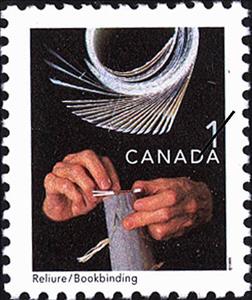Stamp: Bookbinding (Canada 1999)
Bookbinding (Canada 1999)
29 April (Canada ) within release Traditional Trades Definitives goes into circulation Stamp Bookbinding face value 1 Canadian cent
| Stamp Bookbinding in catalogues | |
|---|---|
| Michel: | Mi:CA 1764 |
| Stamp Number: | Sn:CA 1673 |
| Yvert et Tellier: | Yt:CA 1650 |
Stamp is vertical format.
Also in the issue Traditional Trades Definitives:
- Stamp - Bookbinding face value 1;
- Stamp - Decorative Ironwork face value 2;
- Stamp - Weaving face value 5;
- Stamp - Artistic Woodworking face value 10;
- Stamp - Leatherworking face value 25;
- Stamp - Oyster Farming face value 4;
- Stamp - Quilting face value 9;
- Stamp - Glass-blowing face value 3;
|
Data entry completed
83%
|
|
|---|---|
| Stamp Bookbinding in digits | |
| Country: | Canada |
| Date: | 1999-04-29 |
| Size: | 20 x 24 |
| Perforation: | 13 x 13½ |
| Emission: | Definitive |
| Format: | Stamp |
| Face Value: | 1 Canadian cent |
Stamp Bookbinding it reflects the thematic directions:
Art is a diverse range of human activities in creating visual, auditory or performing artifacts (artworks), expressing the author's imaginative or technical skill, intended to be appreciated for their beauty or emotional power. In their most general form these activities include the production of works of art, the criticism of art, the study of the history of art, and the aesthetic dissemination of art. The oldest documented forms of art are visual arts, which include creation of images or objects in fields including painting, sculpture, printmaking, photography, and other visual media. Architecture is often included as one of the visual arts; however, like the decorative arts, or advertising, it involves the creation of objects where the practical considerations of use are essential—in a way that they usually are not in a painting, for example. Music, theatre, film, dance, and other performing arts, as well as literature and other media such as interactive media, are included in a broader definition of art or the arts. Until the 17th century, art referred to any skill or mastery and was not differentiated from crafts or sciences. In modern usage after the 17th century, where aesthetic considerations are paramount, the fine arts are separated and distinguished from acquired skills in general, such as the decorative or applied arts.
A craft or trade is a pastime or an occupation that requires particular skills and knowledge of skilled work. In a historical sense, particularly the Middle Ages and earlier, the term is usually applied to people occupied in small scale production of goods, or their maintenance, for example by tinkers. The traditional term craftsman is nowadays often replaced by artisan and by craftsperson.
A hand is a prehensile, multi-fingered organ located at the end of the forearm or forelimb of primates such as humans, chimpanzees, monkeys, and lemurs. A few other vertebrates such as the koala (which has two opposable thumbs on each "hand" and fingerprints remarkably similar to human fingerprints) are often described as having "hands" instead of paws on their front limbs. The raccoon is usually described as having "hands" though opposable thumbs are lacking.



